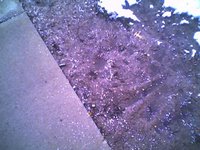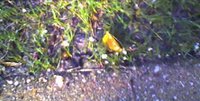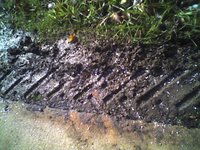
1.) One year spread too much salt in the winter and the grass dies and you get this mud patch. It's a good thing there are no streams around. Studies in the Proceedings of the National Academy of Sciences have noted a disturbing trend caused by overuse of road salt. (see From Icy Roads to Salty Streams and Increased Salinization of fresh water in the northeastern United States.)

2.) Spread some seed in the fall the next year so that you can grow grass in the mud patch from last year. Here are some tender young shoots just starting to make there way in the world.

3.) First snow comes and it is time to pile on the salt. There is so much here I might actually slip on the salt instead of the ice it is attempting to prevent.

Also drive your little tractor to carry the salt and plow the inch of snow on the path. Choose one with wheels
 just wider than the path. Drive through the mud on each side, crushing the new grass in the late fall, before it has time to get established, even if it would have survived the salt.
just wider than the path. Drive through the mud on each side, crushing the new grass in the late fall, before it has time to get established, even if it would have survived the salt.4.) Wait until next fall to start all over again. (Don't plant the grass in the spring, you are showing to much forethought.)
Need I point out the Sisyphean nature of this task? Everybody benefits, grass growers and grass seed sellers, snow plowers and salt spreaders, and salt sellers. It's the free market in action. I hope all of this activity gets counted into the GDP.
No comments:
Post a Comment